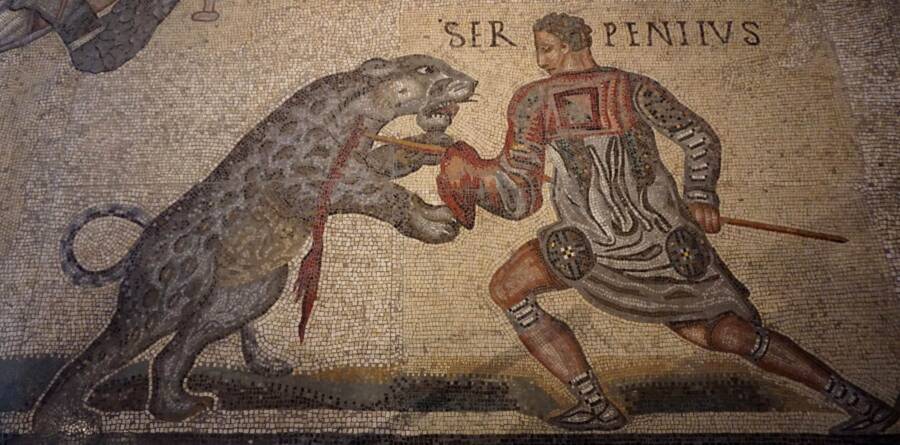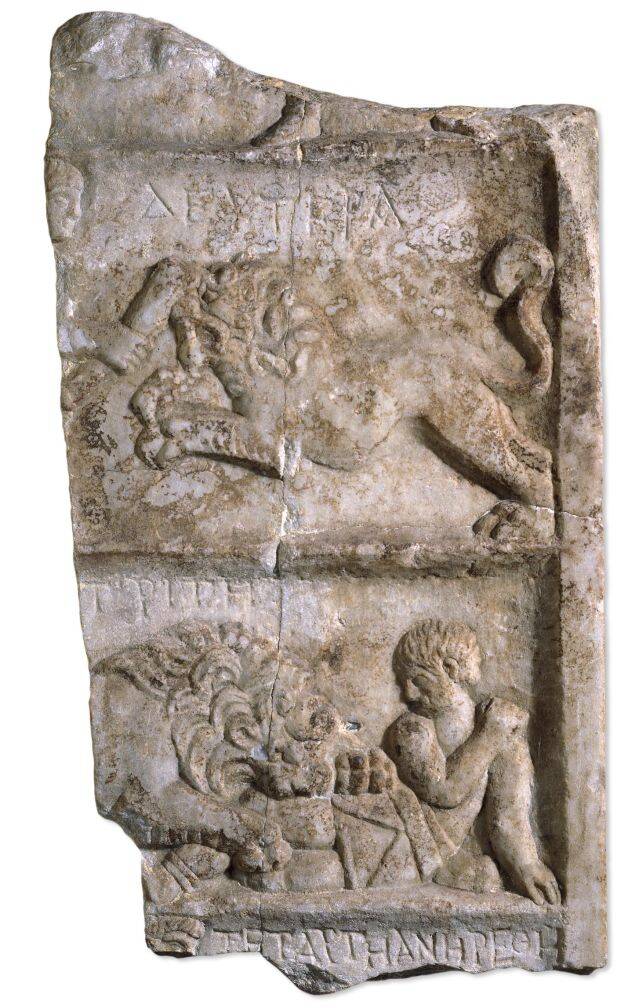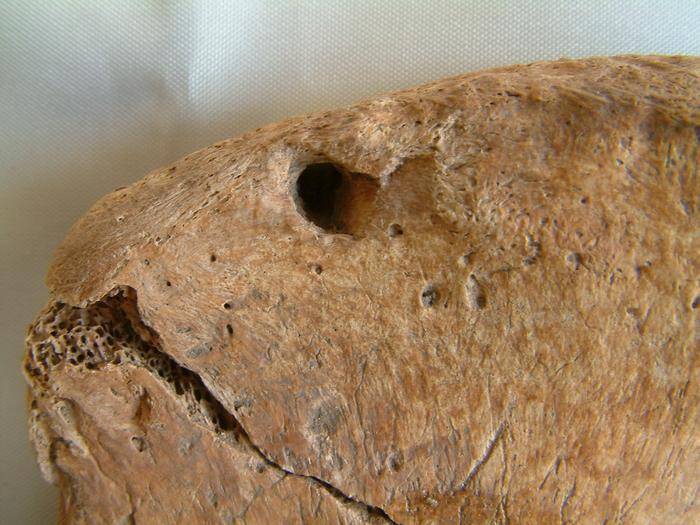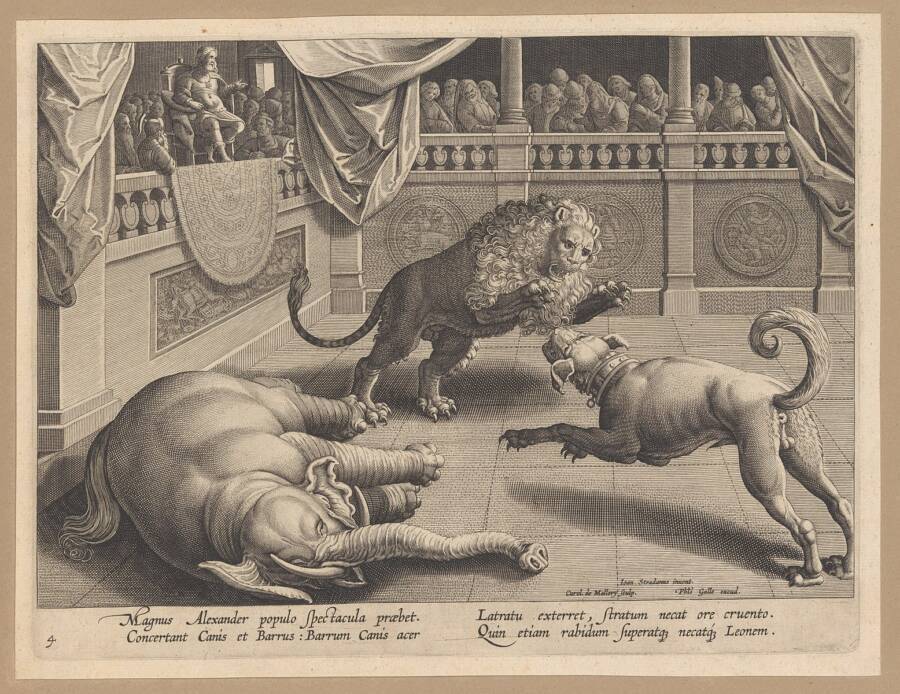Bite marks on the pelvis of an 1,800-year-old skeleton found in York, England just provided the first-ever direct evidence that ancient Roman gladiators were made to fight against great beasts like lions.

Galleria BorgheseWhile ancient Roman mosaics like this one, depicting a battle between man and leopard, have suggested that gladiators were made to fight fearsome beasts, there was no proof — until now.
While excavating what’s believed to be a cemetery for ancient Roman gladiators near York, England, archaeologists came across a decapitated skeleton — with a large bite mark in its pelvis. And according to new research, this bite mark was left by a lion, which had seemingly mauled this unfortunate gladiator in his final moments.
This discovery is the first archaeological evidence of gladiatorial combat between man and beast in the days of ancient Rome.
The First-Ever Evidence Of A Roman Gladiator Battling A Lion

British MuseumA relief showing a gladiator being mauled by a lion. Circa 1st-2nd century C.E.
According to a new study published in the journal PLOS ONE, the mauled man was discovered during excavations at what appears to be a cemetery for gladiators outside of York, England, which was first discovered accidentally by a couple looking to renovate their yard in 2004. Centuries ago, York was as an important Roman military town known as Eboracum.
Between 26 and 35 years old when he died sometime in the third century C.E., roughly 200 years before the fall of Rome, this gladiator was decapitated and had bite marks on his pelvis. These marks were seemingly left by a lion, suggesting that the man died brutally during an animal battle, or venatio, before he was mercifully decapitated.
His last moments would have been “terrifying,” according to Professor Tim Thompson of Maynooth University, the study’s lead author. Thompson told All That’s Interesting: “We believe that the bitemarks are peri-mortem, so at or around the time of death, and so it is likely that the deceased would have been in the same arena as the lion.”
The discovery, he added, “confirms that such spectacle events were occurring, and that the [Roman] Empire had the ability to transport large animals across vast areas of land.”

Maynooth UniversityThe bite mark that the lion left on the gladiator during their fight in the third century C.E.
“This is a hugely exciting find because we can now start to build a better image of what these gladiators were like in life, and it also confirms the presence of large cats, and potentially other exotic animals, in arenas in cities such as York, and how how they too had to defend themselves from the threat of death,” study co-author Malin Holst said in a statement.
She continued: “We often have a mental image of these combats occurring at the grand surroundings of the Colosseum in Rome, but these latest findings show that these sporting events had a far reach, well beyond the centre of core Roman territories. An amphitheatre probably existed in Roman York, but this has not yet been discovered.”
For now, this discovery offers a look at the popular ancient pastime of venationes, staged animal battles that took place across the Roman world.
The Bloody History Of Venationes In Ancient Rome

Harris Brisbane Dick Fund/Wikimedia CommonsA 17th-century print depicting a venatio held in the Colosseum.
The first known venatio took place in 185 B.C.E., when Roman general Marcus Fulvius Nobilior celebrated his military victories by setting up a staged hunt.
“For the first time an athletic contest was on at Rome,” the Roman historian Livy wrote. “And a hunt was staged in which lions and panthers were the quarry, and the games were celebrated with practically all the resources and variety that the entire age could muster.”
In order to stage these battles, the Romans collected exotic animals from all corners of their empire. Lions, panthers, elephants, bears, crocodiles, and rhinos were put in the arena, either to fight each other or to fight specialist gladiators known as venatores. Additionally, condemned criminals were sometimes executed by being thrown into an arena with a wild animal.

Wikimedia CommonsA mosaic showing different kinds of venationes.
Though it’s unknown how this ancient Roman gladiator in York came to fight the lion — gladiators were often slaves, prisoners of war, criminals, or even volunteers — archaeologists have gleaned some clues from his remains. The doomed gladiator was malnourished as a child, he had spinal problems possibly caused by overloading on his back, and he suffered from inflammation of his lung and thigh. When he died, he was buried with two other men and covered up with horse bones.
“This latest research gives us a remarkable insight into the life – and death – of this particular individual, and adds to both previous and ongoing genome research into the origins of some of the men buried in this particular Roman cemetery,” David Jennings, CEO of York Archaeology, said in the statement.
He continued: “We may never know what brought this man to the arena where we believe he may have been fighting for the entertainment of others, but it is remarkable that the first osteo-archaeological evidence for this kind of gladiatorial combat has been found so far from the Colosseum of Rome.”
After reading about the gladiator who died after fighting a lion in ancient Britain, go inside the complicated question of why Rome fell. Then, discover the stories of some of the worst Roman emperors.





